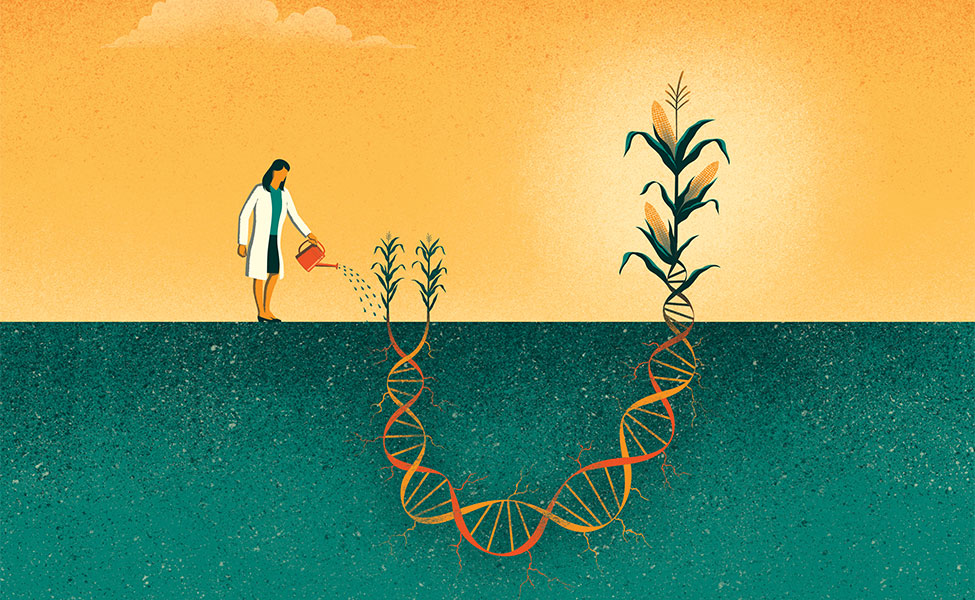Food For Sight
Vitamin A deficiency threatens the vision and lives of millions of children in sub-Saharan Africa. Biofortified staple crops could provide a nutritional safety net.
When Amanda Palmer, PhD ’11, arrived in central Zambia in 2011 to conduct a series of clinical trials, much of the illness she saw was out in the open: endemic malaria, for example, along with respiratory ailments in the dusty dry season and diarrhea in the muddy rainy season. But there was something else lurking in the background, too. A pernicious form of malnutrition was ever present but not always visible: vitamin A deficiency, the leading cause of preventable child blindness in developing countries and a significant cause of child mortality. Vitamin A deficiency is particularly prevalent in sub-Saharan Africa and South Asia, where it affects nearly half of all children and increases the risk of night blindness and mortality among pregnant women—despite the widespread implementation of vitamin A supplementation programs, which distribute tiny capsules of the vital micronutrient to millions of people.
Palmer, now an assistant professor in International Health, was introduced to vitamin A supplements when she helped distribute them in West Africa, first for the Peace Corps and then for Helen Keller International, a nonprofit dedicated to combating blindness and malnutrition. As a graduate student, she worked with UNICEF on its global vitamin A programs while studying under Keith West, DrPH ’86, MPH ’79, RD, an International Health professor and nutrition expert. West helped lay the groundwork for those programs in the 1980s and ’90s while working under Alfred Sommer, MD, MHS ’73, dean emeritus of the Bloomberg School (see "The Gold Standard in Supplementation").
Yet while supplements work wonders—UNICEF estimates that if every child who needed supplements received them, as many as 1 million lives could be saved each year—even massive distribution campaigns can’t reach everyone who requires them. And industrially fortifying foods does not always work in developing countries, where it can be difficult to identify a commonly eaten food that can be centrally—and reliably—processed. Several Central American countries, for example, have successfully reduced vitamin A deficiency by fortifying sugar with vitamin A; but as one of Palmer’s students recently demonstrated, attempts to do so in Zambia failed due to flawed fortification processes.
Now, Palmer is focusing her efforts on biofortification, a method of boosting foods’ vitamin and mineral content. Biofortification would allow vulnerable populations to grow and eat their own nutritionally enhanced crops, sidestepping many of the obstacles to supplementation and industrial fortification.

Palmer recently concluded a series of three clinical trials involving biofortified maize in Zambia. The maize was donated by HarvestPlus, a nonprofit dedicated to addressing malnutrition in the developing world, and was developed by the Zambia Agriculture Research Institute in conjunction with the International Maize and Wheat Improvement Center.
Agricultural researchers in Zambia and the U.S. selectively crossbred and cultivated various strains of maize to increase the concentration of pigments known as carotenoids. In addition to making carrots orange and mangoes yellow, carotenoids furnish the raw material our bodies need to produce the active form of the vitamin, also called retinol. The most famous carotenoid, beta-carotene, is the primary precursor of vitamin A.
For Palmer’s studies, HarvestPlus supplied a strain of maize that contains so much beta-carotene—15 to 20 times more than the amount found in the ordinary white maize Zambians normally eat—that it resembles a fat, knobby carrot.
Getting enough carotene into maize to improve a person’s vitamin A status is one thing. But getting enough orange maize into a person while meeting the rigorous requirements of a clinical trial is quite another.
Zambians grind maize into meal and consume it as a porridge called nshima. Were they to grow their own orange maize, they could have it milled locally and eat it without any fuss whatsoever. But in order to compare the effect of eating biofortified maize with the effect of eating ordinary white maize (provided with or without fortification or supplements, depending on the trial), Palmer chose to run all her trials in Mkushi District, an agricultural region where orange maize had not yet been released, so that she could strictly control participants’ access to it.
To get nearly 500 of the preschool-aged children enrolled in her first Mkushi trial to eat the orange maize twice a day, six days a week, Palmer set up a network of 51 kitchens staffed by 105 cooks. (For comparison’s sake, more than 400 other children ate ordinary white maize.) Since carotenoids degrade when exposed to heat and light, she had the orange maize meal delivered in refrigerated trucks. And to ensure that participants would consume the entire measured dose, she mixed in a traditional relish made from cabbage, onions and tomatoes grown by local farmers.
In a second trial, conducted in 2013, Palmer used the same food-delivery system to feed her biofortified maize to lactating mothers to see if it would increase the level of vitamin A in their breast milk. (Some mothers instead received white maize and a vitamin A supplement.) And in a third and final trial involving both mothers and their babies, she had the meals delivered by motorcycle in insulated containers. “It’s really difficult to get moms to come to the kitchen every day, because they’re really busy,” she says. “So we actually did home delivery.” In that study, Palmer set out to compare the effects of orange maize, ordinary white maize and white maize that she personally fortified with retinol at a local mill.
“Now that I’m talking about it, it’s bringing back all the logistical headaches involved in getting the food out,” she says with a sigh.
The headaches, however, paid off. In a series of papers published over the past year, Palmer and her colleagues have already demonstrated that the orange maize improved children’s eye function and raised the level of beta-carotene in their blood. It also reduced the prevalence of low vitamin A levels in the milk of lactating mothers. Results from the mothers-and-babies trial will be available this fall.
Palmer is quick to point out that the orange maize was not as effective as the supplements or the fortified maize. Nonetheless, in a country where the prevalence of vitamin A deficiency can reach 50 percent—and indeed for much of sub-Saharan Africa, where vitamin A deficiency is widespread and maize is a popular food—the promise of a new tool for combating this form of “hidden hunger” is good news.
It is also good news for the rest of the developing world.
Even if they can’t access fortified foods, they could grow this themselves. And they could sell their surplus to other people.
Ideally, everyone would derive sufficient vitamin A from diet alone. But poor people in rural locations can neither obtain nor afford the foods that are richest in retinol: animal sources like liver, eggs and dairy products. Nor are kids anywhere likely to consume enough of the plant sources that are highest in carotenoids—namely, green leafy vegetables. “Young children don’t eat green leafy vegetables, whether they’re in Baltimore or Bangladesh,” says West.
Because of that—and also because of the limitations of supplementation and industrial fortification—the WHO still considers vitamin A deficiency a problem in more than half of all countries, and Helen Keller International estimates that as many as half a million children go blind because of it every year, with half of them dying within a year of losing their sight. In addition, says Sommer, deficiency-related night blindness is so common among pregnant women in some cultures that it’s considered to be “a natural part of pregnancy.”
Researchers have therefore turned to biofortification, which has the advantage of delivering carotene through foods that vulnerable populations normally consume. The poster child for biofortification, golden rice—which Palmer plans to use in an upcoming trial in Bangladesh—was genetically engineered 20 years ago to contain sky-high amounts of beta-carotene. But the anti-GMO movement has largely blocked its adoption, so scientists have instead focused on using traditional breeding techniques to raise carotene levels in other staple crops like bananas, cassava, sweet potato—and maize.
Palmer’s work with orange maize in Zambia bolsters the case for biofortification as a means of combating vitamin A deficiency. And it supports the idea that biofortification could help address deficiencies in other micronutrients like zinc and iron.
“Theoretically, it should go a long way toward solving the problem,” says Sommer, who believes that if researchers can figure out how to boost beta-carotene levels in staple crops even higher, they might largely do away with the need for the supplements he pioneered.
Palmer sees biofortification as one of several strategies for improving the vitamin A status of vulnerable groups and as a nutritional safety net for people who might not receive supplements. Ideally, she explains, organizations like HarvestPlus would supply orange maize to subsistence farmers in poor rural areas and let them take it from there.
“Even if they can’t access fortified foods,” she says, “they could grow this themselves. And they could sell their surplus to other people.”
Something similar could occur if golden rice were introduced to the rice fields of poor farmers in rural India and Bangladesh. Palmer is currently scouting a site in the latter country, where she hopes to run a trial involving a high-risk, marginalized population. Because of the ongoing resistance to genetically engineered crops, she admits, “it’s going to be politically very challenging,” but she and her colleagues are undeterred.
Because when it comes to biofortification, you only reap what you can sow.
